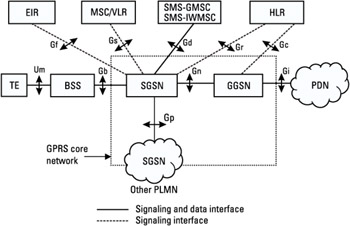GPRS Logical Architecture
3.1 GPRS Logical Architecture
Figure 3.1 shows the elements that are part of a GPRS network and their associated interfaces. A GPRS network is composed of the following network nodes:
-
SGSN. The SGSN is the node that is serving the MS; it is responsible for GMM. It delivers packets to the MSs and communicates with the HLR to obtain the GPRS subscriber profile. It manages the registration of the new mobile subscribers in order to keep a record of their LA for routing purposes. The SGSN can be connected to one or several BSSs.
-
GGSN. The GGSN provides interworking with external packet data networks (PDNs). It may be linked to one or several data networks. It is connected with SGSNs via an IP-based GPRS backbone network. The GGSN is a router that forwards incoming packets from the external PDN to the SGSN of the addressed MS. It also forwards outgoing packets to the external PDN. The PDN is the external fixed data network to which is connected the GPRS network. An example of a PDN is the Internet network.
-
HLR. The HLR is a database that contains, among other things, packet domain subscription data and routing information.
-
Mobile switching center/visitor location register (MSC/VLR). The MSC coordinates the setting up of calls to and from GSM users and manages GSM mobility. The MSC is not directly involved in the GPRS network. It forwards circuit-switched paging for the GPRS-attached MSs to the SGSN when the Gs interface is present.
-
BSS. The BSS ensures the radio connection between the mobile and the network. It is responsible for radio access management. The BSS is composed of two elements: the BTS and the BSC. The BTS integrates all the radio transmission and radio reception boards. The BSC is responsible for the management of the radio channels. The BSC has switching capabilities that are used for circuit-switched calls and can also be used for GPRS traffic.
-
EIR. The EIR is a database that contains terminal identities.
 Figure 3.1: GPRS network architecture.
Figure 3.1: GPRS network architecture.






